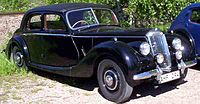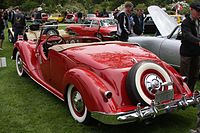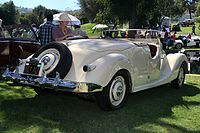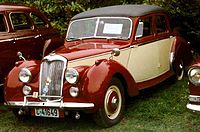Riley RM
| Riley RM Series | |
|---|---|
FR layout | |
| Dimensions | |
| Wheelbase | 1.5 L cars – 112 in (2,845 mm) 2.5 L cars – 119 in (3,023 mm) |
| Length | 1.5 L cars – 179 in (4,547 mm) 2.5 L cars – 186 in (4,724 mm) |
| Width | 63 in (1,600 mm) |
| Height | 59 in (1,499 mm) |
| Chronology | |
| Predecessor |
|
| Successor | Riley Pathfinder |
The Riley RM Series is an
There were four types of RM vehicles produced. All used Riley engines with four cylinders in-line, hemispherical combustion chambers and twin camshafts mounted high at the sides of the cylinder block.
The RMA was a large
The RMB was a longer car, and it was replaced by the RMF. Both cars used a larger engine, new in 1937, a 2.5 L 16 hp (RAC Rating) "Big Four".
The RMC and RMD were limited-production cars, an open 2 or 3-seater Roadster and a 4-seater
The Riley Pathfinder was the RMH and the last saloon to have the Riley Big Four engine.
Kestrel

The RM was inspired by Riley Motors' successful and stylish pre-war 1.5 and 2.5 Litre Kestrel Saloons but the new cars featured a new chassis. The new chassis with its Riley "torsionic" independent front-wheel suspension incorporated the experience of the wartime years.[2]
The RM series was new because the patterns of dies for the old models were destroyed in the air raids on Coventry.[3]
Riley RMA
| Riley RMA | |
|---|---|
Straight-4 as for 2.5-litre Big Four but bore 69mm by stroke 100mm and bhp 60 @5,300 rpm[4] | |
| Chronology | |
| Predecessor | Riley 12/4 and Riley 12 |
| Successor | Riley RME |
The RMA was the first post-war
-
Riley RMA 1½-Litre 4-Door Saloon 1949
-
Riley RMA 1½-Litre 4-Door Saloon 1952
Riley RMB
| Riley RMB | |
|---|---|
Straight-4 | |
| Dimensions | |
| Wheelbase | 119 in (3,023 mm)[6] |
| Length | 186 in (4,724 mm)[6] |
| Width | 63.5 in (1,613 mm)[6] |
| Height | 59 in (1,499 mm)[6] |
| Chronology | |
| Successor | Riley RMF |
The 2.5 L (2443 cc) RMB was a lengthened RMA launched a year later in 1946.
It used the 2.5 L (2443 cc) "Big Four" engine with twin SU carburettors, starting with 90 hp (67 kW) but increasing to 100 hp (75 kW) for 1948 with a 95 mph (153 km/h) top speed.
The wheelbase was 6.5 in (165 mm) longer and the overall length was a full 7 in (178 mm) longer. The RMB was replaced by the RMF for 1952.
The RMB 2½ Litre models have light blue bonnet and bootlid badges, differentiating them from the RMA 1½ Litre models which have dark blue badges.[7]
A car tested by
-
Riley RMB 2½-Litre 4-Door Saloon 1949
-
Riley RMB 2½-Litre 4-Door Saloon 1950
Riley RMC
| Riley RMC | |
|---|---|
Straight-4 |
The RMC (Roadster) was an open 2-door, single bench seat, 2/3-seater version of the RMB, with a large rear deck area and fold-flat windscreen. Announced in March 1948, it was delivered to Geneva just too late to be exhibited at the Geneva Motor Show. Primarily designed for the North American export market, it was normally built with left-hand drive, with the gear change lever on the steering column. The bonnet and radiator were lowered and the bonnet catches were arranged to be operated internally. Extra over-riders were fitted to the bumpers and the fuel tank was enlarged to 20 imp gal (91 L; 24 US gal).[9]
Eighteen months later, in September 1949, Riley announced future production would include a small quota of cars with right-hand drive. Riley attributed that to a slight increase in the supply of steel.[10]
Instead of side windows it was supplied with flexible celluloid-glazed side curtains with a hole for hand signals and, when deployed, flimsy synthetic roofing over a light metal frame. It shared that car's 2.5 L 100 hp (75 kW) engine, and could reach 100 mph (160 km/h).[citation needed]
Just over 500 were built from 1948 until 1951.[citation needed]
-
1948 in Canada
-
1949 in USA
Both the back and front of the car bore a remarkable likeness to a 1934 Ford V8.
Riley RMD
| Riley RMD | |
|---|---|
Straight-4 |
The RMD (drophead) was a traditional 2-door
This new body was first displayed in October 1948 at London's Earls Court Motor Show.[11]
 A motor car that is a cabriolet has fixed sides to its roof known as cant rails and a folding top that remains part of the vehicle. In a cabriolet like this Riley RMD the tops of the fixed sides, the cant rails, the beams over the side-windows, may be folded along with the top. While the hood is being opened or closed the heavy cant rail beams are supported by exterior hood irons. The hood irons, an elongated S-shape when the roof is up, may be seen at each of the roof's rear quarters. A more English name for a folding cover or canopy of a (horse drawn) vehicle enabling the occupants to be seen clearly is a "head" or for motor vehicles in the mid-20th century drop head.[12] |
-
Riley RMD 2½-Litre Drophead Coupé 1950
-
Riley RMD 2½-Litre Drophead Coupé 1950
Riley RME
| Riley RME | |
|---|---|
Straight-4 | |
| Chronology | |
| Predecessor | Riley RMA |
| Successor | Riley One-Point-Five (1957) |
Released in 1952, the RME was an improved RMA.[13] It still used the 1.5 L four and featured a fully hydraulic braking system. The body had an enlarged rear window with curved glass. To improve acceleration the rear axle ratio was changed from 4.89:1 to 5.125:1.[14]
When the 2.5 L (2443 cc) car ended production in October 1953 a switch to no running boards was amongst many updates to the RME including wholly new shaped front mudguards.
Produced from 1952, it was discontinued in 1955 and ultimately its place in the range went in 1957 to the much shorter and unrelated, intended but unused, replacement for the Morris Minor —
An RME tested by The Motor magazine in 1952 had a top speed of 75 mph (121 km/h) and could accelerate from 0–60 mph (97 km/h) in 29.5 seconds. A fuel consumption of 24.2 mpg‑imp (11.7 L/100 km; 20.2 mpg‑US) was recorded. The test car cost £1,339 including taxes.[14]

-
Riley RME 1½-Litre 4-Door Saloon
Riley RMF
| Riley RMF | |
|---|---|
Straight-4 | |
| Chronology | |
| Predecessor | Riley RMB |
| Successor | Riley Pathfinder |
The RMF replaced the RMB in 1952. It shared that car's 2.5 L "Big Four" engine as well as the mechanical updates from the RME. The RMH Riley Pathfinder, the last automobile to use the Riley "Big Four" engine, and thus considered to be the last "real" Riley by purists, took its place after 1953 and continued in production until 1957.
The RMF 2½ Litre models have light blue bonnet and bootlid badges, differentiating them from the RME 1½ Litre models which have dark blue badges.[7]
Riley 2½-litre Big Four engine
The Big Four engine is a four cylinder 2.5 litre engine rated at 16.07 h.p. under the British RAC formula. It was designed in a matter of months, under difficult financial conditions, and announced in the summer of 1937. It followed existing Riley practice, similar to their 1.5 litre engine, but with each cylinder completely surrounded by a water jacket. The fully counter-weighted and balanced crankshaft ran in three main bearings. Pre-war power output was initially 80 bhp (60 kW), then raised to 85 bhp (63 kW).[15] In its final Riley Pathfinder form, it developed 110 bhp (82 kW) and was produced until the end of Riley Pathfinder production in February 1957.[16]
| Riley 2½-litre Big Four engine | |
|---|---|
| Overview | |
Cooling system | water, thermostatically controlled flow, belt-driven water pump and radiator fan[17] |
| Output | |
| Power output | 106 bhp @ 4,500 rpm Tax rating 16hp[18] |
| Chronology | |
| Predecessor | none before 1937 |
| Successor | Riley RMH then BMC C-Series engine |
Bibliography
- A-Z of Cars 1945–1970. Michael Sedgwick and Mark Gillies. Bayview Books. 1989. ISBN 1-870979-39-7
- Book by James Taylor - RILEY RM-SERIES - ISBN 9780947981365
- Book by John Price Williams - The Legendary RMs - ISBN 9781861267610
- Ramsey, John. The Swapmeet and Toyfair Catalogue of British Diecast Model Toys. Swapmeet Toys and Models Ltd. p. 29. ISBN 095093190X
References
- ^ "British car brochures www.car-brochures.eu — Riley adverts". Archived from the original on 30 July 2023. Retrieved 20 September 2023.
- The Manchester Guardian(1901-1959). Manchester. 28 November 1945. p. 6.
- The Manchester Guardian(1901-1959). Manchester. p. 5.
- ^ "Cars of To-Day". The Times. No. 47540. 24 November 1936. p. 12.
- ^ "City Notes". The Times. No. 50229. 24 August 1945. p. 7.
- ^ The Motor. 1949.
- ^ a b Malpas, Rob. "Frequently Asked Questions". rileyrob.co.uk.
- ^ "Riley 2½-Litre RMC". www.classicandsportscar.com.
- ^ "News in Brief". The Times. No. 51033. 31 March 1948. p. 2.
- ^ "Nuffield Cars For Motor Show". The Times. No. 51482. 9 September 1949. p. 2.
- ^ "New Nuffield Cars". The Times. No. 51212. 26 October 1948. p. 2.
- ^ OED Online. Oxford University Press, December 2015. Web. 13 January 2016.
- HEAD
- CABRIOLET
- ISBN 9781870979092.
- ^ The Motor. 10 December 1952.
- ^ a b Birmingham, Dr. Anthony Terence (1 January 1965). Riley: The Production and Competition History of the Pre-1939 Riley Motor Cars. G. T. Foulis and Co. Ltd.
- ISBN 9780956967633.
- ^ a b c d e "Cars of To-Day". The Times. No. 47634. 16 March 1937. p. 22.
- ^ a b c d e f g h Malpas, Rob. "Healey Silverstone. (1949–51)". rileyrob.co.uk.









